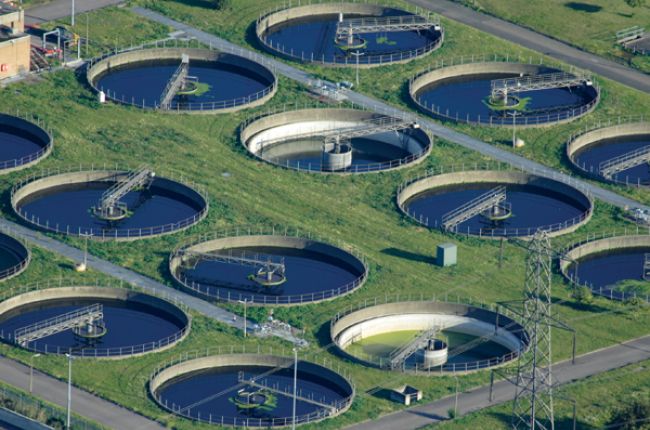Reliable Waste Water Treatment Systems: Trick Techniques and Benefits
Wiki Article
Checking Out Innovative Technologies and Practices for Reliable Waste Water Therapy Equipments
Reliable waste water therapy systems are crucial for ecological sustainability and public health and wellness. From sophisticated purification techniques to wise monitoring systems and biological therapy technologies, the area of waste water treatment is experiencing an improvement.Advanced Filtration Methods

Microfiltration entails using great membranes to different particles and bacteria, while ultrafiltration targets also smaller pollutants with finer pores. Nanofiltration services getting rid of organic molecules and divalent ions, and turn around osmosis is highly reliable in getting rid of liquified salts and various other pollutants. Waste Water Treatment. These approaches not only help in generating clean water however additionally help in decreasing the environmental effect of wastewater discharges, making them important parts of modern wastewater treatment systems

Smart Checking Systems
The implementation of clever monitoring systems changes the oversight and administration of wastewater therapy procedures, guaranteeing optimal efficiency and conformity with regulative criteria. These systems use advanced sensors, information analytics, and real-time monitoring to give valuable understandings into various specifications of the therapy process. This positive strategy allows for quick interventions to attend to concerns before they intensify, inevitably enhancing the general effectiveness and performance of the treatment plant.Biological Treatment Innovations
Biological treatment technologies have actually considerably advanced the efficiency and sustainability of wastewater therapy processes. One such advancement is making use of membrane bioreactors (MBRs), which incorporate biological treatment with membrane layer purification to attain better treated water in a smaller sized impact contrasted to standard approaches. MBRs effectively remove microorganisms, solids, and impurities, creating effluent that satisfies rigid regulative requirements. One more notable development is the application of bioaugmentation, where specialized microbial cultures are introduced to enhance the degradation of specific pollutants, boosting therapy performance. In addition, the advancement of built wetlands has obtained grip as a all-natural and energy-efficient biological treatment solution. These crafted ecosystems harness marsh plants and microbial processes to get rid of pollutants from wastewater efficiently. Generally, biological treatment advancements use affordable, ecologically friendly remedies for wastewater treatment, promoting sustainable methods in water resource administration. Executing these technologies can result in better water quality, minimized environmental influence, and boosted resource healing in wastewater treatment systems.Energy-Efficient Practices
In progressing the sustainability of wastewater treatment systems, energy-efficient methods play a crucial duty in enhancing functional costs and minimizing ecological impact. One crucial energy-efficient technique is read more the application of innovative aeration systems, such as fine bubble diffusers or surface area aerators, which boost oxygen transfer efficiency in biological treatment procedures. By enhancing oygenation performance, therapy plants can reduce energy article source usage connected with oygenation, a significant contributor to total power usage in wastewater treatment.
Moreover, the integration of sustainable energy sources, like photovoltaic panels or wind generators, can aid counter power demands and reduce reliance on standard nonrenewable fuel sources. Using power recuperation systems, such as warmth exchangers or biogas record modern technologies, can additionally add to power cost savings by repurposing waste warmth and recording biogas produced throughout treatment processes.
Furthermore, utilizing power management systems and progressed control approaches can optimize power usage by adjusting operational parameters in real-time based on differing therapy conditions. In general, incorporating energy-efficient practices not just minimizes operational costs yet additionally lessens the environmental footprint of wastewater treatment facilities, lining up with sustainable advancement objectives and governing needs.
Data-Driven Optimization
Just how can data-driven optimization improve the effectiveness and effectiveness of wastewater therapy systems? Data-driven optimization plays a crucial duty in enhancing the performance of wastewater therapy systems by allowing real-time surveillance, anticipating maintenance, and notified decision-making - Waste Water Treatment. By collecting and evaluating data from numerous sensors and resources within the treatment plant, drivers can acquire beneficial insights into the system's procedure, identify possible issues prior to they escalate, and enhance processes to accomplish better resultsVia data-driven optimization, operators can apply predictive upkeep techniques that assist prevent devices failings and minimize downtime. By analyzing historical information and patterns, maintenance schedules can be maximized, resulting in set you back savings and boosted system integrity. Additionally, real-time information tracking anonymous permits prompt detection of anomalies or inconsistencies from optimal operating conditions, making it possible for prompt restorative activities to be taken.
Additionally, data-driven optimization assists in data-driven decision-making by giving operators with actionable insights and suggestions based on information evaluation - Waste Water Treatment. This enables continuous enhancement and optimization of wastewater therapy procedures, bring about improved efficiency, minimized functional prices, and boosted total performance of the system
Conclusion
To conclude, the expedition of innovative technologies and practices for efficient waste water treatment systems has revealed promising lead to enhancing filtering techniques, monitoring systems, biological treatments, energy performance, and information optimization. These advancements are essential in attending to the growing difficulties of water shortage and contamination. By implementing these solutions, we can ensure reliable and lasting administration of wastewater resources for the benefit of both the setting and culture.From sophisticated filtering methods to clever surveillance systems and organic treatment developments, the field of waste water therapy is observing a change.Organic treatment advancements have actually considerably advanced the efficacy and sustainability of wastewater therapy processes. Overall, organic treatment developments offer cost-efficient, ecologically friendly remedies for wastewater treatment, advertising lasting techniques in water source management. By boosting aeration performance, treatment plants can reduce power consumption linked with aeration, a significant factor to overall power use in wastewater treatment.
In verdict, the exploration of innovative innovations and practices for effective waste water therapy systems has revealed promising outcomes in enhancing purification approaches, checking systems, biological therapies, energy performance, and information optimization.
Report this wiki page